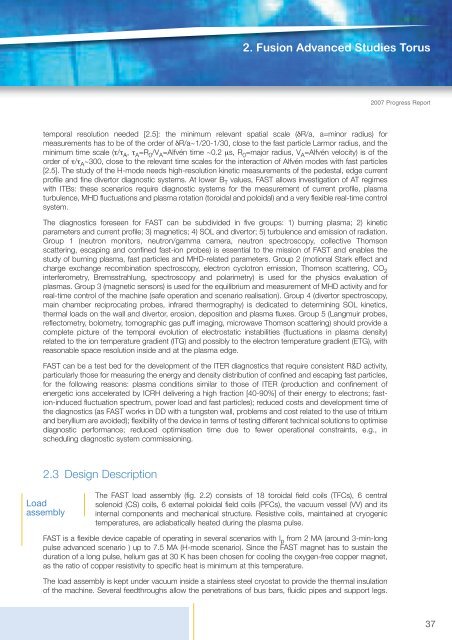Fusion Programme - ENEA - Fusione
Fusion Programme - ENEA - Fusione
Fusion Programme - ENEA - Fusione
- No tags were found...
You also want an ePaper? Increase the reach of your titles
YUMPU automatically turns print PDFs into web optimized ePapers that Google loves.
2. <strong>Fusion</strong> Advanced Studies Torus2007 Progress Reporttemporal resolution needed [2.5]: the minimum relevant spatial scale (δR/a, a=minor radius) formeasurements has to be of the order of δR/a~1/20-1/30, close to the fast particle Larmor radius, and theminimum time scale (τ/τ A ,τ A =R 0 /V A =Alfvén time ~0.2 μs, R 0 =major radius, V A =Alfvén velocity) is of theorder of τ/τ A ~300, close to the relevant time scales for the interaction of Alfvén modes with fast particles[2.5]. The study of the H-mode needs high-resolution kinetic measurements of the pedestal, edge currentprofile and fine divertor diagnostic systems. At lower B T values, FAST allows investigation of AT regimeswith ITBs: these scenarios require diagnostic systems for the measurement of current profile, plasmaturbulence, MHD fluctuations and plasma rotation (toroidal and poloidal) and a very flexible real-time controlsystem.The diagnostics foreseen for FAST can be subdivided in five groups: 1) burning plasma; 2) kineticparameters and current profile; 3) magnetics; 4) SOL and divertor; 5) turbulence and emission of radiation.Group 1 (neutron monitors, neutron/gamma camera, neutron spectroscopy, collective Thomsonscattering, escaping and confined fast-ion probes) is essential to the mission of FAST and enables thestudy of burning plasma, fast particles and MHD-related parameters. Group 2 (motional Stark effect andcharge exchange recombination spectroscopy, electron cyclotron emission, Thomson scattering, CO 2interferometry, Bremsstrahlung, spectroscopy and polarimetry) is used for the physics evaluation ofplasmas. Group 3 (magnetic sensors) is used for the equilibrium and measurement of MHD activity and forreal-time control of the machine (safe operation and scenario realisation). Group 4 (divertor spectroscopy,main chamber reciprocating probes, infrared thermography) is dedicated to determining SOL kinetics,thermal loads on the wall and divertor, erosion, deposition and plasma fluxes. Group 5 (Langmuir probes,reflectometry, bolometry, tomographic gas puff imaging, microwave Thomson scattering) should provide acomplete picture of the temporal evolution of electrostatic instabilities (fluctuations in plasma density)related to the ion temperature gradient (ITG) and possibly to the electron temperature gradient (ETG), withreasonable space resolution inside and at the plasma edge.FAST can be a test bed for the development of the ITER diagnostics that require consistent R&D activity,particularly those for measuring the energy and density distribution of confined and escaping fast particles,for the following reasons: plasma conditions similar to those of ITER (production and confinement ofenergetic ions accelerated by ICRH delivering a high fraction [40-90%] of their energy to electrons; fastion-inducedfluctuation spectrum, power load and fast particles); reduced costs and development time ofthe diagnostics (as FAST works in DD with a tungsten wall, problems and cost related to the use of tritiumand beryllium are avoided); flexibility of the device in terms of testing different technical solutions to optimisediagnostic performance; reduced optimisation time due to fewer operational constraints, e.g., inscheduling diagnostic system commissioning.2.3 Design DescriptionLoadassemblyThe FAST load assembly (fig. 2.2) consists of 18 toroidal field coils (TFCs), 6 centralsolenoid (CS) coils, 6 external poloidal field coils (PFCs), the vacuum vessel (VV) and itsinternal components and mechanical structure. Resistive coils, maintained at cryogenictemperatures, are adiabatically heated during the plasma pulse.FAST is a flexible device capable of operating in several scenarios with I p from 2 MA (around 3-min-longpulse advanced scenario ) up to 7.5 MA (H-mode scenario). Since the FAST magnet has to sustain theduration of a long pulse, helium gas at 30 K has been chosen for cooling the oxygen-free copper magnet,as the ratio of copper resistivity to specific heat is minimum at this temperature.The load assembly is kept under vacuum inside a stainless steel cryostat to provide the thermal insulationof the machine. Several feedthroughs allow the penetrations of bus bars, fluidic pipes and support legs.37













